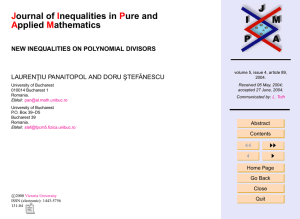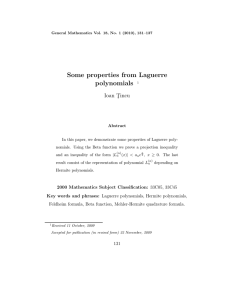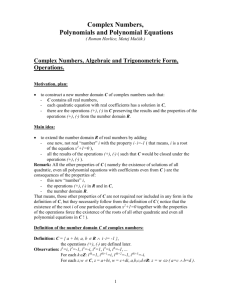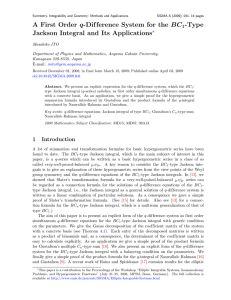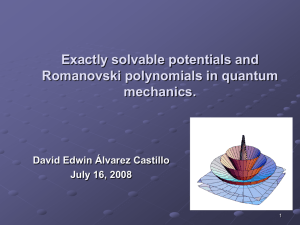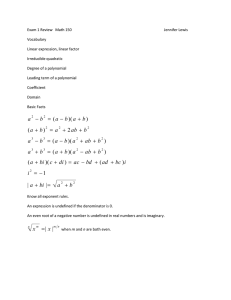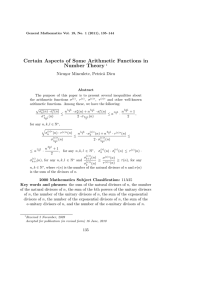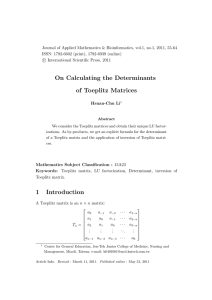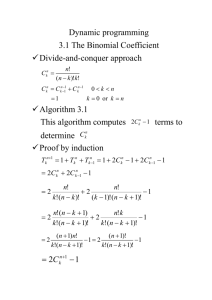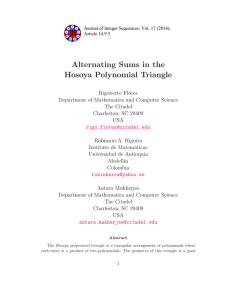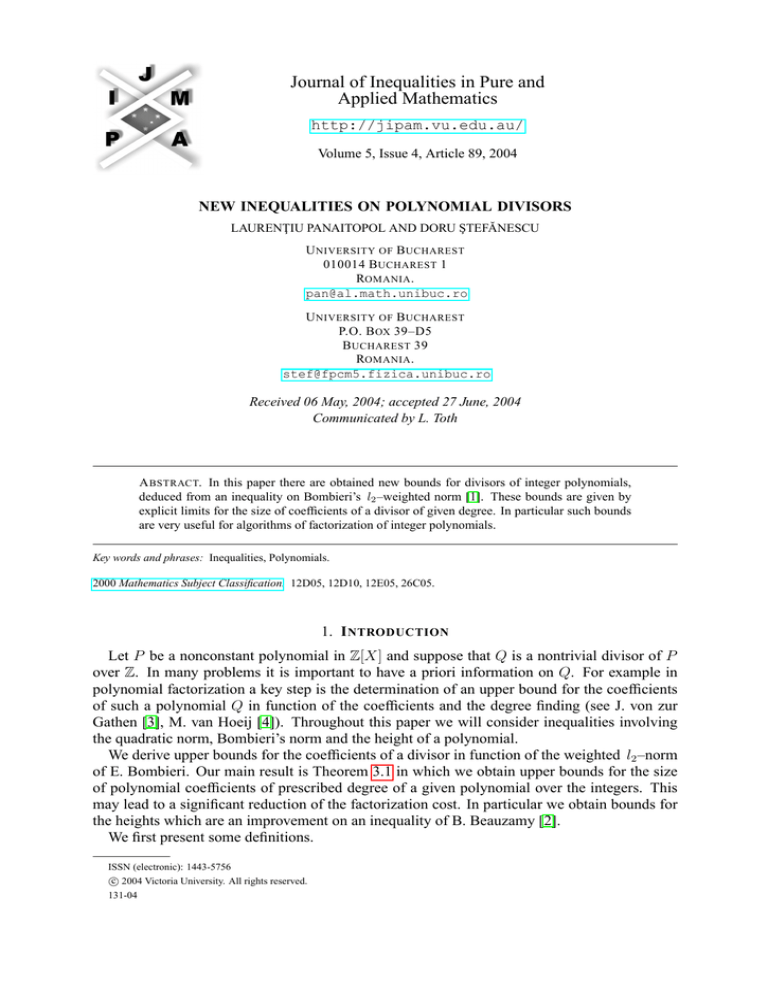
Journal of Inequalities in Pure and
Applied Mathematics
http://jipam.vu.edu.au/
Volume 5, Issue 4, Article 89, 2004
NEW INEQUALITIES ON POLYNOMIAL DIVISORS
LAURENŢIU PANAITOPOL AND DORU ŞTEFĂNESCU
U NIVERSITY OF B UCHAREST
010014 B UCHAREST 1
ROMANIA .
pan@al.math.unibuc.ro
U NIVERSITY OF B UCHAREST
P.O. B OX 39–D5
B UCHAREST 39
ROMANIA .
stef@fpcm5.fizica.unibuc.ro
Received 06 May, 2004; accepted 27 June, 2004
Communicated by L. Toth
A BSTRACT. In this paper there are obtained new bounds for divisors of integer polynomials,
deduced from an inequality on Bombieri’s l2 –weighted norm [1]. These bounds are given by
explicit limits for the size of coefficients of a divisor of given degree. In particular such bounds
are very useful for algorithms of factorization of integer polynomials.
Key words and phrases: Inequalities, Polynomials.
2000 Mathematics Subject Classification. 12D05, 12D10, 12E05, 26C05.
1. I NTRODUCTION
Let P be a nonconstant polynomial in Z[X] and suppose that Q is a nontrivial divisor of P
over Z. In many problems it is important to have a priori information on Q. For example in
polynomial factorization a key step is the determination of an upper bound for the coefficients
of such a polynomial Q in function of the coefficients and the degree finding (see J. von zur
Gathen [3], M. van Hoeij [4]). Throughout this paper we will consider inequalities involving
the quadratic norm, Bombieri’s norm and the height of a polynomial.
We derive upper bounds for the coefficients of a divisor in function of the weighted l2 –norm
of E. Bombieri. Our main result is Theorem 3.1 in which we obtain upper bounds for the size
of polynomial coefficients of prescribed degree of a given polynomial over the integers. This
may lead to a significant reduction of the factorization cost. In particular we obtain bounds for
the heights which are an improvement on an inequality of B. Beauzamy [2].
We first present some definitions.
ISSN (electronic): 1443-5756
c 2004 Victoria University. All rights reserved.
131-04
2
L AUREN ŢIU PANAITOPOL AND D ORU Ş TEFĂNESCU
Definition 1.1. Let P (X) =
Pn
j=0
aj X j ∈ C[X]. The quadratic norm of P is
v
uX
u n
||P || = t
|aj |2 .
j=0
The weighted l2 –norm of Bombieri is
v
uX
n
|aj |2
u
.
[P ]2 = t
j=0
n
j
The height of P is
H(P ) = max |a0 |, |a1 |, . . . , |an | .
The measure of P is
Z
1
M(P ) = exp
2iπt
dt .
logP e
0
Note that
H(P ) ≤
n
· M(P ),
bn/2c
||P || ≤
2n
n
12
· M(P ),
H(P ) ≤ 2n · M(P ).
Bombieri’s norm and the height are used in estimations of the absolute values of the coefficients
of polynomial divisors of integer polynomials. This reduces to the evaluation of the height of
the divisors. We mention the evaluation of B. Beauzamy:
P
• If P (X) = ni=0 ai X i ∈ Z[X], n ≥ 1 and Q is a divisor of P in Z[X], then
H(Q) ≤
(1.1)
33/4 · 3n/2
[P ]2 .
2(π n)1/2
(B. Beauzamy [2]).
2. I NEQUALITIES ON FACTORS OF C OMPLEX P OLYNOMIALS
We derive inqualities on the coefficients of divisors of complex polynomials, using a well–
known inequality on Bombieri’s norm [1] and an idea of B. Beauzamy [2].
Proposition 2.1. If
P (X) = an X n + an−1 X n−1 + · · · + a1 X + a0 ∈ C[X] \ C,
P (0) 6= 0, n ≥ 3 and
Q(X) = bd X d + bn−1 X d−1 + · · · + b1 X + b0 ∈ C[X]
is a nontrivial divisor of P of degree d ≥ 2, then
! 2
2
2
|a0 |
|an |
|bi |
n
+
|b0 |2 + |bd |2 + d ≤
[P ]22 ,
2
2
|b0 |
|bd |
d
i
J. Inequal. Pure and Appl. Math., 5(4) Art. 89, 2004
for all
i = 1, 2, . . . , d − 1.
http://jipam.vu.edu.au/
N EW I NEQUALITIES ON P OLYNOMIAL D IVISORS
3
Proof. By an inequality of B. Beauzamy, E. Bombieri, P. Enflo and H. Montgomery [1] (cf.
also B. Beauzamy [2]), it is known that if P = QR in C[X], then
21
n
[P ]2 ≥ [Q]2 [R]2 .
d
(2.1)
Note that
|a0 |2 |an |2
+
.
|b0 |2
|bd |2
[R]22 ≥ |R(0)|2 + |lc(R)|2 =
Therefore, by (2.1),
[P ]2 ≥
(2.2)
|a0 |2
|b0 |2
+
|an |2
|bd |2
[Q]2
.
1
n 2
d
r
But a lower bound for [Q]2 is |b0 |2 + |bd |2 +
|a0 |2 |an |2
+
|b0 |2
|bd |2
|bi |2
(di)
. Therefore
|bi |2
|b0 |2 + b|d |2 + d
i
!
n
≤
[P ]22 .
d
Corollary 2.2. For all i ∈ {1, 2, . . . , d − 1} we have
s −1
d n
|a0 |2 |an |2
d
|bi | ≤
+
[P ]22 −
(|b0 |2 + |bd |2 ).
2
2
i
d
|b0 |
|bd |
i
3. B OUNDS FOR D IVISORS OF I NTEGER P OLYNOMIALS
For polynomials with integer cofficients Corollary 2.2 allows us to give upper bounds for the
heights of polynomial divisors.
P
P
Theorem 3.1. Let P (X) = ni=0 ai X i ∈ Z[X] \ Z and let Q(X) = di=0 ai X i ∈ Z[X] be a
nontrivial divisor of P in Z[X], with 1 ≤ d ≤ n − 1. If n = deg(P ) ≥ 4 and P (0) 6= 0, then
s d
1 n
2
2
(3.1)
|bi | ≤
[P ]2 − a0 − a2n
for all i.
i
2 d
Proof. We consider first the case d = 1. We have
divides a0 or an , so
d
i
= 1 and i = 0 or i = 1. Therefore bi
b2i ≤ a20 + a2n .
As n ≥ 4 it follows that
1
b2i ≤ 2(a20 + a2n ) − (a20 + a2n ) ≤ n[P ]22 − a20 − a2n .
2
Consider now d ≥ 2.
J. Inequal. Pure and Appl. Math., 5(4) Art. 89, 2004
http://jipam.vu.edu.au/
4
L AUREN ŢIU PANAITOPOL AND D ORU Ş TEFĂNESCU
For i = 0 we have
1
b20 ≤ a20 ≤ a20 + a2n = 4(a20 + a2n ) − a20 − a2n
2
1
≤ n(a20 + a2n ) − a20 − a2n
2 1 n
(a20 + a2n ) − a20 − a2n
≤
2 d
d
1 n
2
2
2
2
≤
(a0 + an ) − a0 − an .
i
2 d
The same argument holds for i = d.
We suppose now 1 ≤ i ≤ d − 1. First we consider the case
a0 an = = 1.
b0 bd We have
2 2
a0
an
+
=2
b0
bd
and the inequality follows from Corollary 2.2.
If
a0 > 1 or an > 1,
bd b0 we have
2 2
an
a0
+
≥5
b0
bd
and by Proposition 2.1 we have
d
1 n
2
2
2
2
bi ≤
[P ]2 − b0 − bd .
i
5 d
To conclude, it is sufficient to prove that
1 n
1 n
2
2
2
[P ]2 − b0 − bd ≤
[P ]22 − a20 − a2n ,
5 d
2 d
i.e.
1 1
n
−
[P ]22 ≥ a20 + a2n − b20 − b2d ,
2 5
d
which follows from
3
12 2
n[P ]22 ≥
a0 + a2n > a20 + a2n − b20 − b2d .
10
10
Corollary 3.2. If n = deg(P ) ≥ 4 and d = deg(Q) we have
s
s d
1 n
H(Q) ≤
·
[P ]22 − a20 − a2n .
bd/2c
2 d
Corollary 3.3. If n = deg(P ) ≥ 6 we have
s 1
d
n
H(Q) ≤
·
[P ]22 − 2(a20 + a2n ) .
2 bd/2c
d
J. Inequal. Pure and Appl. Math., 5(4) Art. 89, 2004
http://jipam.vu.edu.au/
N EW I NEQUALITIES ON P OLYNOMIAL D IVISORS
5
Proof. For d = deg(Q) = 1 we put Q(X) = b0 + b1 X. Then b0 divides a0 and b1 divides an .
So
n−4 2
H(Q)2 < a20 + a2n ≤
(a0 + a2n ) .
2
But this is equivalent to the
statement.
d
For d ≥ 2 we have bd/2c
≥ 2 and the inequality follows by Corollary 3.2.
Corollary 3.4. For n = deg(P ) ≥ 6 we have
r
3(2n+3)/2 2
H(Q) ≤
[P ]2 − a20 − a2n .
4π n
Proof. By a B. Beauzamy result we have
1
d
3(2n+3)/2
≤
.
2 bd/2c
4π n
Corollary 3.5. If deg(P ) ≥ 6 we have
r
H(Q) ≤
3(2n+3)/2 2
[P ]2 − 2(a20 + a2n ) .
4π n
Proof. We use Corollary 3.3 and the proof of Corollary 3.4.
4. E XAMPLES
We compare now the various results throughout the paper. We also compare them with estimates of B. Beauzamy [2]. The computations are done using the gp–package.
4.1. Prescribed coefficients. In polynomial factorization we are ultimately interested in knowing the size of coefficients of an arbitrary divisor of prescribed degree. We consider the folllowing bounds for the ith coefficient of a divisor of degree d of the polynomial P :
q 1 d
B1 (P, d, i) =
· nd [P ]2
(B. Beauzamy [2]),
2 i
B2 (P, d, i) =
q q d
· 12 nd [P ]22 − a20 − a2n
i
(Theorem 3.1).
Let
Q1 = x4 + x + 1,
Q2 = 7x5 + 12x4 + 11,
Q3 = 11x7 − x5 + x + 1,
Q4 = 111x7 − x5 + x3 + x + 2,
Q5 = 3x7 + 12x6 − x + 37,
Q6 = 4x11 + x8 + 8x7 − x5 + x3 + x + 2,
Q7 = 113x11 + 2x9 − 13x8 + x7 − x4 + 3x2 + 2x + 91,
Q8 = x15 + 30x4 + 5x3 + 2x2 + 5x + 2.
J. Inequal. Pure and Appl. Math., 5(4) Art. 89, 2004
http://jipam.vu.edu.au/
6
L AUREN ŢIU PANAITOPOL AND D ORU Ş TEFĂNESCU
P
Q1
Q1
Q1
Q1
Q2
Q2
Q3
Q3
Q3
Q3
Q3
Q3
Q3
Q4
Q5
Q6
Q6
Q6
Q6
Q7
Q7
Q8
Q8
Q8
Q8
Q8
d
3
3
3
3
3
3
5
5
5
6
6
6
6
6
6
9
9
10
10
8
10
13
13
14
14
14
i B1 (P, d, i) B2 (P, d, i)
0
2.12
1.58
1
3.67
2.73
2
3.67
2.73
3
2.12
1.58
0
31.52
28.70
1
54.60
49.71
0
35.81
34.07
1
80.09
76.19
2
113.26
107.79
0
20.68
17.48
1
50.65
42.82
2
80.09
67.71
3
92.48
78.18
5
508.75
429.97
1
171.38
145.27
1
70.88
69.59
3
216.54
212.62
1
33.41
30.27
4
153.11
138.72
2 6973.46
6931.07
2 2282.60
2064.71
1
71.15
70.70
5
708.01
703.45
2
71.15
67.88
3
142.31
135.77
6
408.77
389.97
Table 1
4.2. Divisors of prescribed degree. We consider now bounds for divisors of given degree d.
Let
s 1
d
n
B1 (P, d) =
· [P ]2
2 bd/2c
d
s
(B. Beauzamy [2]),
s d
1 n
·
[P ]22 − a20 − a2n
bd/2c
2 d
(Corollary 3.2),
s 1
d
n
B3 (P, d) =
·
[P ]22 − 2(a20 + a2n )
2 bd/2c
d
(Corollary 3.3)
B2 (P, d) =
We have B3 (P, d) < B2 (P, d) < B1 (P, d). The bounds B2 (P, d) and B3 (P, d) are better
for polynomials with large leading coefficients and and large free terms.
J. Inequal. Pure and Appl. Math., 5(4) Art. 89, 2004
http://jipam.vu.edu.au/
N EW I NEQUALITIES ON P OLYNOMIAL D IVISORS
7
Considering the polynomials
R1 = x5 + 13x4 + x + 101,
R2 = 11x7 − x5 + x + 1,
R3 = 11x7 − x5 + x + 34,
R4 = 14x11 − 3x2 + x + 29,
R5 = 12x15 − x14 + x12 − x11 + 2x9 + 5x4 + 5x3 + 2x2 + 5x + 16,
we obtain
P
R1
R1
R1
R1
R2
R2
R3
R4
R4
R4
R5
R5
R5
R5
R5
d
1
2
3
4
4
5
4
2
9
10
1
2
12
13
14
B1 (P, d)
159.96
319.93
391.84
391.84
113.26
113.26
366.20
238.84
1895.80
1199.01
54.89
205.41
9190.89
6016.85
3216.14
B2 (P, d)
143.96
303.57
371.80
350.61
111.64
110.54
360.93
236.66
1878.49
1143.22
53.04
204.43
9180.83
5988.26
3107.60
B3 (P, d)
—
—
—
—
109.99
107.74
355.58
234.46
1861.02
1084.57
51.12
203.45
9170.76
5959.54
2995.12
Table 2
4.3. Arbitrary divisors. Finally we consider bounds for an arbitrary divisor of a polynomial
P . We put
33/4 · 3n/2
· [P ]2
2(πn)1/2
r
3(2n+3)/2 2
B2 (P ) =
[P ]2 − a20 − a2n
4π n
r
3(2n+3)/2 2
[P ]2 − 2(a20 + a2n )
B3 (P ) =
4π n
We always have B3 (P ) < B2 (P ) < B1 (P ).
If we consider
B1 (P ) =
(B. Beauzamy [2]) ,
(n ≥ 4, Corollary 3.4) ,
(n ≥ 6, Corollary 3.5).
R6 = 12x6 − 2x4 + x + 11,
R7 = x6 − x3 + 11,
R8 = 2x6 − x3 + 114,
R9 = 2x9 + x5 + 11,
R10 = 2x11 − x6 + x5 + 119.
we get
J. Inequal. Pure and Appl. Math., 5(4) Art. 89, 2004
http://jipam.vu.edu.au/
8
L AUREN ŢIU PANAITOPOL AND D ORU Ş TEFĂNESCU
P
B1 (P ) B2 (P ) B3 (P )
R6 115.47 114.33 113.16
R7
78.30
77.52
76.73
R8 808.15 800.07 791.90
R9 336.22 336.02 335.85
R10 9712.13 9711.41 9710.68
Table 3
R EFERENCES
[1] B. BEAUZAMY, E. BOMBIERI, P. ENFLO AND H. MONTGOMERY, Products of polynomials in
many variables, J. Number Theory, 36 (1990), 219–245.
[2] B. BEAUZAMY, Products of polynomials and a priori estimates for coefficients in polynomial decompositions: A sharp result, J. Symb. Comp., 13 (1992), 463–472.
[3] J. VON ZUR GATHEN
Press (1999).
AND
J. GERHARD, Modern Computer Algebra, Cambridge University
[4] M. VAN HOEIJ, Factoring polynomials and the knapsack problem, preprint (2001).
[5] M. MIGNOTTE, An inequality about factors of polynomials, Math. Comp., 28 (1974), 1153–1157.
[6] L. PANAITOPOL AND D. ŞTEFĂNESCU, Height bounds for integer polynomials, J. Univ. Comp.
Sc., 1 (1995), 599–609.
J. Inequal. Pure and Appl. Math., 5(4) Art. 89, 2004
http://jipam.vu.edu.au/

